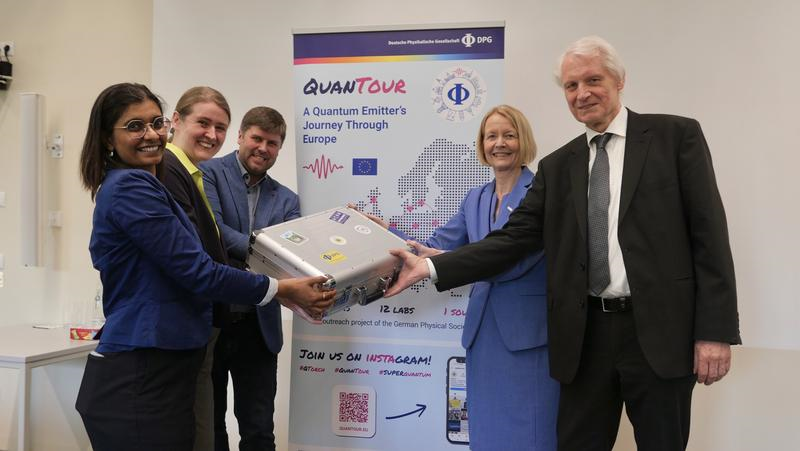Quantum “Torch” Begins Its Relay
Like the flame that started its journey today from Ancient Olympia to the 2024 Olympic Games in Paris, a “quantum torch” has just begun its tour of Europe to mark the coming International Year of Quantum Science and Technology in 2025. The kickoff ceremony of this QuanTour project occurred in Berlin on Sunday, World Quantum Day. The quantum torch—a microscopic device in the shape of a dartboard—emits light one photon at a time, exemplifying the precise control at the core of quantum technologies. “We want to get everyone excited about quantum physics,” says QuanTour organizer Doris Reiter of the Technical University of Dortmund, Germany.
The quantum torch, which was fabricated by Tobias Heindel and his group at the Technical University of Berlin, is scheduled to visit 12 different labs in 12 different countries during the next 12 months. At each stop, there will be events tied to the International Year of Quantum Science and Technology—a global initiative highlighting the contribution of quantum physics to our daily lives. QuanTour organizers are planning public demonstrations of quantum mechanics concepts and “behind the scenes” visits of quantum physics labs. Videos will also be aired of scientists explaining their work to science communicator and QuanTour organizer Pranoti Kshirsagar.
The launch ceremony included talks on the importance of quantum science and technology in our daily lives. Claus Lämmerzahl, a theoretical physicist from the University of Bremen, Germany, and the spokesperson for the German Physical Society (DPG), provided motivation for the upcoming Year of Quantum. He says that 2025 was chosen because it commemorates the 100-year anniversary of Werner Heisenberg’s theoretical breakthrough in formulating the mathematics of quantum mechanics. “Quantum theory is one of the fundamental findings of humankind,” Lämmerzahl says.
Next year also marks the 125th anniversary of Max Planck’s introduction of the concept of “quanta”—packets of energy that could explain the spectra of light from thermal sources, such as a flaming torch. Cornelia Denz, the president of the German National Metrology Institute (PTB), recounted the efforts at the end of the 19th century that led to that development and to single-photon quantum light sources, such as the quantum torch. “The quantum emitter is so important for quantum technology,” Denz says.
One key use of the single-photon emitter is in communication. “Quantum physics can provide enhanced security and functionality to our communication networks,” Heindel says. That enhanced security relies on single-photon emitters, he says, as these devices can provide a steady stream of photons that are highly sensitive to any type of eavesdropping.
Heindel, whose research focuses on quantum communication, described QuanTour’s quantum torch device as “a nanophotonic dartboard” with a quantum-dot emitter sitting at the bullseye. The 4-µm-wide device is etched into a thin slab of gallium arsenide, a semiconductor material, and consists of concentric rings around the central dot. The rings enhance the rate at which single photons are produced, and they orient the emission of the photons in the direction perpendicular to the dartboard’s plane.
Users can test the quantum nature of the torch by performing a so-called Hanbury-Brown-Twiss (HBT) experiment. In such a demonstration, the light from a device is sent into a beam splitter that has a detector at each of its two outputs. A time delay is introduced to one of the detectors, and the number of coincident photon detections are counted as the time delay is varied.
If the source of the light is classical (as is the case for a light bulb or a burning flame), then the measurements should show a large peak at zero-time delay. For a single quantum emitter, users should see a dip, as the single-photon source produces no coincident counts for zero-time delay. Scientists will perform this HBT experiment at each of the 12 labs and then present the data to the public.
The kickoff ceremony ended with a skit that featured a pair of guards wearing “Quantum Security” uniforms escorting in a suitcase carried by Technical University of Berlin graduate student Lucas Rickert. The suitcase was opened, and viewers were offered a peak at the quantum torch packed inside. The QuanTour organizers then closed the suitcase and slapped on to it travel “stickers” from the DPG and other supporting institutions. The quantum torch was ready for its first trip to Linz, Austria (the public can follow its progress on social media).
–Michael Schirber
Michael Schirber is a Corresponding Editor for Physics Magazine based in Lyon, France.







